Microstructural Evolution and Mechanical Evaluation of a Laser-Induced Composite Coating on a Ni-Based Superalloy during Thermal Exposure
Abstract
:1. Introduction
2. Materials and Methods
3. Results and Discussion
3.1. Microstructure of the Coating before Thermal Exposure
3.2. Microstructure of the Coating after Thermal Exposure
3.3. Mechanical Behavior of the Coating before and after Thermal Exposure
4. Conclusions
- (1)
- The novel approach involved took advantage of the triggering effect of Si in promoting the precipitation of Mo carbides and Ni–Si intermetallics. The coating obtained primarily consisted of the Mo6Ni6C, γ-Ni31Si12, and a mixture of α-Ni (s.s) and β1-Ni3Si eutectics. The volume fraction of the hard phases (Mo6Ni6C, γ-Ni31Si12, and β1-Ni3Si) reached up to 85%.
- (2)
- High-temperature (1073 K) thermal exposure promoted the transformation of nickel silicides (γ-Ni31Si12 and β1-Ni3Si) to Mo6Ni6C. The supersaturation of carbon in the nickel silicides was the critical reason for inducing their instability. In addition, the deficiency of Mo in the original Mo6Ni6C caused them to break up and become granulated.
- (3)
- We found E and H for the Mo6Ni6C, γ-Ni31Si12, and α-Ni (s.s) to be 399.6 and 24.9, 327.2 and 19.6, and 275.6 and 6.1 GPa, respectively.
- (4)
- The nanoscratch tests indicated that the hard phases (Mo6Ni6C, γ-Ni31Si12, and β1-Ni3Si) in the coating had a strong ability to resist local wear.
- (5)
- The Vickers microhardness values of the nonaged and aged coatings were always higher than that of the substrate. Thermal exposure, however, lowered the hardness of the coating, compared to the nontreated one.
Author Contributions
Funding
Conflicts of Interest
References
- Lin, Y.C.; Nong, F.Q.; Chen, X.M.; Chen, D.D.; Chen, M.S. Microstructural evolution and constitutive models to predict hot deformation behaviors of a nickel based superalloy. Vacuum 2017, 137, 104–114. [Google Scholar] [CrossRef]
- Hashim, M.; Babu, K.E.S.R.; Duraiselvam, M.; Natu, H. Improvement of wear resistance of Hastelloy C-276 through laser surface melting. Mater. Des. 2013, 46, 546–551. [Google Scholar] [CrossRef]
- Ouyang, F.Y.; Chang, C.H.; Kai, J.J. Long-term corrosion behaviors of Hastelloy N and Hastelloy B3 in moisture-containing molten FLiNaK salt environments. J. Nucl. Mater. 2014, 446, 81–89. [Google Scholar] [CrossRef]
- Mulligan, C.P.; Wei, R.; Yang, G.; Zheng, P.; Deng, R.; Gall, D. Microstructure and age hardening of C276 alloy coatings. Surf. Coat. Technol. 2015, 270, 299–304. [Google Scholar] [CrossRef]
- Kim, W.G.; Yin, S.N.; Ryu, W.S.; Chang, J.H.; Kim, S.J. Tension and creep design stresses of the “Hastelloy-X” alloy for high-temperature gas cooled reactors. Mater. Sci. Eng. A 2008, 483–484, 495–497. [Google Scholar] [CrossRef]
- Liu, T.; Dong, J.S.; Xie, G.; Wang, L.; Lou, L.H. Effect of silicon on microstructure and stress rupture properties of a corrosion resistant Ni-based superalloy during long term thermal exposure. Mater. Sci. Eng. A 2016, 656, 75–83. [Google Scholar] [CrossRef]
- He, Y.M.; Zheng, W.J.; Yang, J.G.; Zhu, D.D.; Yang, X.S.; Gao, Z.L. An analysis of high-temperature microstructural stability and mechanical performance of the Hastelloy N-Hastelloy N Superalloy joint bonded with pure Ti. Mater. Des. 2018, 144, 72–85. [Google Scholar] [CrossRef]
- Liu, Y.; Yang, C.; Gao, Z.L.; Yao, Y. Ensemble deep kernel learning with application to quality prediction in industrial polymerization processes. Chemometr. Intell. Lab. 2018, 174, 15–21. [Google Scholar] [CrossRef]
- Zheng, W.J.; Liu, Y.; Gao, Z.L.; Yang, J.G. Just-in-time semi-supervised soft sensor for quality prediction in industrial rubber mixers. Chemometr. Intell. Lab. 2018, 180, 36–41. [Google Scholar] [CrossRef]
- Jiang, W.C.; Chen, W.; Woo, W.; Tu, S.T.; Em, V. Effects of low-temperature transformation and transformation-induced plasticity on weld residual stresses: numerical study and neutron diffraction measurement. Mater. Des. 2018, 147, 65–79. [Google Scholar] [CrossRef]
- Li, Y.; Chopra, N. Graphene encapsulated gold nanoparticle-quantum dot heterostructures and their electrochemical characterization. Appl. Surf. Sci. 2015, 344, 27–32. [Google Scholar] [CrossRef]
- He, Y.M.; Lu, C.Y.; Zheng, W.J.; Yang, J.G.; Chen, S.J.; Li, Z.J.; Sun, Y.; Gao, Z.L. Microstructural modification and mechanical characterization for a laser-induced composite coating during thermal exposure. Surf. Coat. Technol. 2019, 358, 11–21. [Google Scholar] [CrossRef]
- Liu, F.J.; Ji, Y.; Meng, Q.S.; Li, Z.S. Microstructure and corrosion resistance of laser cladding and friction stir processing hybrid modification Al-Si coatings on AZ31B. Vacuum 2016, 133, 31–37. [Google Scholar] [CrossRef]
- Vreeling, J.A.; Ocelik, V.; Hosson, J.T.M.D. Ti-6Al-4V strengthened by laser melt injection of WCp particles. Acta Mater. 2002, 50, 4913–4924. [Google Scholar] [CrossRef]
- Pei, Y.T.; Ocelik, V.; Hosson, J.T.M.D. SiCp/Ti6Al4V functionally graded materials produced by laser melt injection. Acta Mater. 2002, 50, 2035–2051. [Google Scholar] [CrossRef]
- Verdi, D.; Garrido, M.A.; Múnez, C.J.; Poza, P. Cr3C2 incorporation into an Inconel 625 laser cladded coating: effects on matrix microstructure, mechanical properties and local scratch resistance. Mater. Des. 2015, 67, 20–27. [Google Scholar] [CrossRef]
- Wang, D.S.; Tian, Z.J.; Wang, S.L.; Shen, L.D.; Liu, Z.D. Microstructural characterization of Al2O3-13 wt.% TiO2 ceramic coatings prepared by squash presetting laser cladding on GH4169 superalloy. Surf. Coat. Technol. 2014, 254, 195–201. [Google Scholar] [CrossRef]
- Wang, Q.Y.; Zhang, Y.F.; Bai, S.L.; Liu, Z.D. Microstructures, mechanical properties and corrosion resistance of Hastelloy C22 coating produced by laser cladding. J. Alloys Compd. 2013, 553, 253–258. [Google Scholar] [CrossRef]
- Wang, Q.Y.; Bai, S.L.; Zhao, Y.H.; Liu, Z.D. Effect of mechanical polishing on corrosion behavior of Hastelloy C22 coating prepared by high power diode laser cladding. Appl. Surf. Sci. 2014, 303, 312–318. [Google Scholar] [CrossRef]
- Wang, H.M.; Wang, C.M.; Cai, L.X. Wear and corrosion resistance of laser clad Ni2Si/NiSi composite coatings. Surf. Coat. Technol. 2003, 168, 202–208. [Google Scholar] [CrossRef]
- Cai, L.X.; Wang, C.M.; Wang, H.M. Laser cladding for wear-resistant Cr-alloyed Ni2Si-NiSi intermetallic composite coatings. Mater. Lett. 2003, 57, 2914–2918. [Google Scholar] [CrossRef]
- He, Y.M.; Yang, J.G.; Fu, W.; Wang, L.M.; Gao, Z.L. An analysis of formation mechanism and nano-scale hardness of the laser-induced coating on Ni17Mo7Cr based superalloy. J. Alloys Compd. 2016, 673, 8–16. [Google Scholar] [CrossRef]
- Lu, X.D.; Wang, H.M. High-temperature phase stability and tribological properties of laser clad Mo2Ni3Si/NiSi metal silicide coatings. Acta Mater. 2004, 52, 5419–5426. [Google Scholar] [CrossRef]
- Williams, T.M.; Titchmarsh, J.M. The occurrence of a silicon-rich phase of the M6C type in neutron-irradiated FV548 steel. J. Nucl. Mater. 1979, 87, 398–400. [Google Scholar] [CrossRef]
- Chao, Y.B.; Ren, H.T.; Hu, C.S.; Meng, Q.X.; Liu, Q. In-situ formation behavior of NbC-reinforced Fe-based laser cladding coatings. Mater. Lett. 2015, 147, 61–63. [Google Scholar] [CrossRef]
- Bhushan, B.; Li, X.D. Nanomechanical characterization of solid surfaces and thin films. Int. Mater. Rev. 2003, 48, 125–164. [Google Scholar] [CrossRef]
- Ahmad, R.; Cochrane, R.F.; Mullis, A.M. The formation of regular αNi-γNi31Si12 eutectic structures from undercooled Ni-25 at.% Si melts. Intermetallics 2012, 22, 55–61. [Google Scholar] [CrossRef]
- Tasgin, Y.; Kaplan, M.; Yaz, M. Investigation of effects of boron additives and heat treatment on carbides and phase transition of highly alloyed duplex cast iron. Mater. Des. 2009, 30, 3174–3179. [Google Scholar] [CrossRef]
- Gülpen, J.H.; Kodentsov, A.A.; Loo, F.J.J.V. Growth of silicides in Ni-Si and Ni-SiC bulk diffusion couples. Z. Metallkd. 1995, 86, 530–539. [Google Scholar] [CrossRef]
- Pike, L.M.; Liu, C.T. Environmental effects on the tensile properties of two Ni3Si-based alloys. Scr. Mater. 2000, 42, 265–270. [Google Scholar] [CrossRef]
- Ackerbauer, S.; Krendelsberger, N.; Weitzer, F.; Hiebl, K.; Schuster, J.C. The constitution of the ternary system Fe-Ni-Si. Intermetallics 2009, 17, 414–420. [Google Scholar] [CrossRef]
- Himuro, Y.; Tanaka, Y.; Ohnuma, I.; Kainuma, R.; Ishida, K. Phase equilibria and γ′-L12 phase stability in the Ni-rich portion of Ni-Fe-Si and Ni-Fe-Al systems. Intermetallics 2005, 13, 620–630. [Google Scholar] [CrossRef]
- Taub, A.I.; Briant, C.L. Improved ductility of Ni3Si by micro-alloying with boron or carbon. Metall. Trans. A 1989, 20A, 2025–2032. [Google Scholar] [CrossRef]
- Jang, J.S.C.; Cheng, C.Y.; Wang, S.K. The effect of carbon microalloying on the microstructure and mechanical properties of a nickel silicide-based alloy. Mater. Chem. Phys. 2001, 72, 66–71. [Google Scholar] [CrossRef]
- Zhao, J.C.; Henry, M.F. The thermodynamic prediction of phase stability in multicomponent superalloys. JOM 2002, 54, 37–41. [Google Scholar] [CrossRef]
- Reddy, G.V.P.; Harini, P.; Sandhya, R.; Rao, K.B.S.; Paretkar, R.K. On dual-slope linear cyclic hardening of Hastelloy X. Mater. Sci. Eng. A 2010, 527, 3848–3851. [Google Scholar] [CrossRef]
- Feng, D. Phase Transformation. In The Physics of Metal; Science Publisher: Beijing, China, 1995; pp. 156–158. [Google Scholar]
- Zhou, S.F.; Zeng, X.Y.; Hu, Q.W.; Huang, Y.J. Analysis of crack behavior for Ni-based WC composite coatings by laser cladding and crack-free realization. Appl. Surf. Sci. 2008, 255, 1646–1653. [Google Scholar] [CrossRef]
- Cao, L.G.; Cochrane, R.F.; Mullis, A.M. Lamella structure formation in drop-tube processed Ni-25.3 at.% Si alloy. J. Alloys Compd. 2014, 615S, 599–601. [Google Scholar] [CrossRef]
- Zhu, J.H.; Liu, C.T. Intermediate-temperature mechanical properties of Ni-Si alloys: Oxygen embrittlement and its remedies. Intermetallics 2002, 10, 309–316. [Google Scholar] [CrossRef]
- Takasugi, T.; Kawai, H.; Kaneno, Y. The effect of Cr addition on mechanical and chemical properties of Ni3Si alloys. Mater. Sci. Eng. A 2002, 329–331, 446–454. [Google Scholar] [CrossRef]
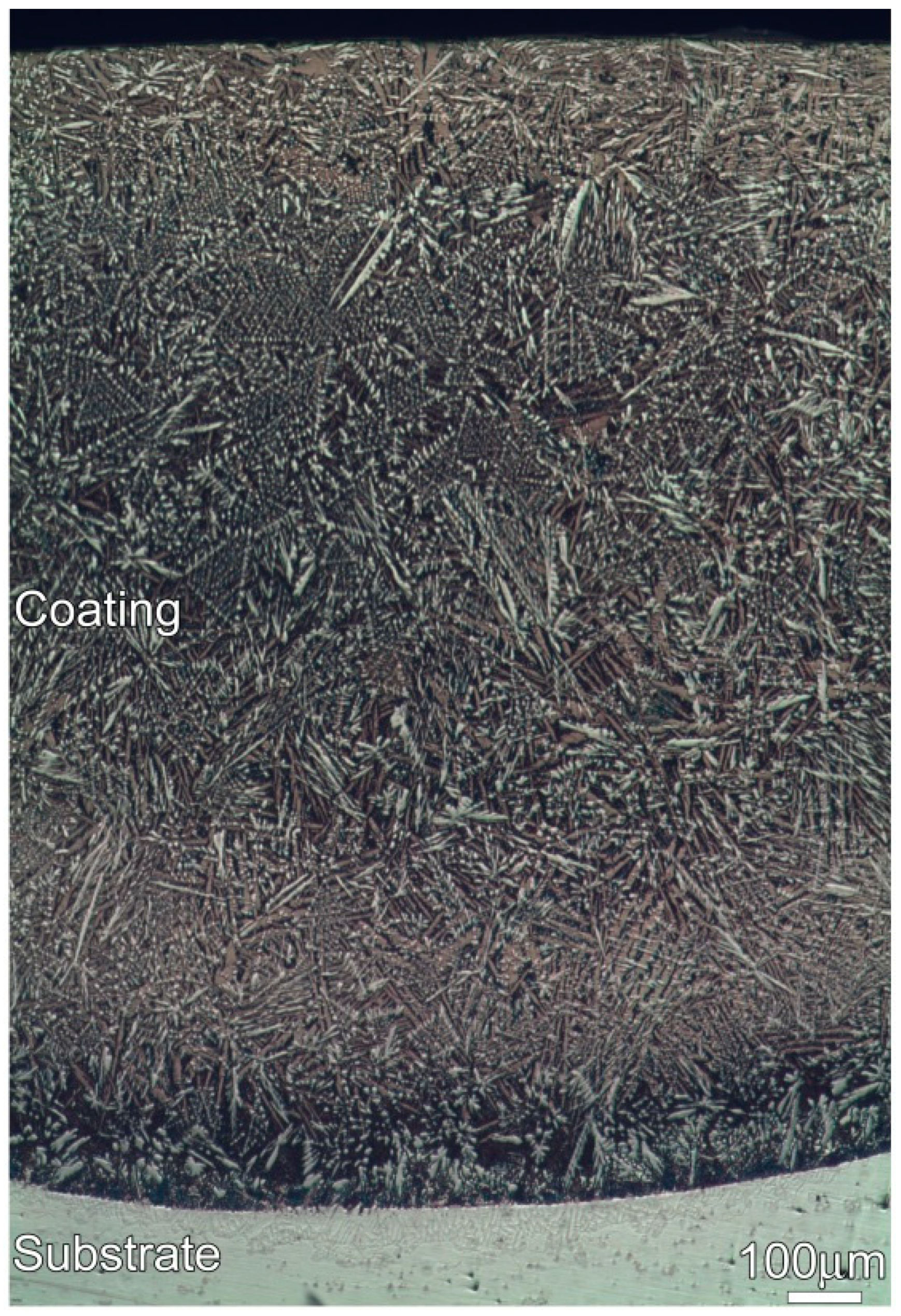
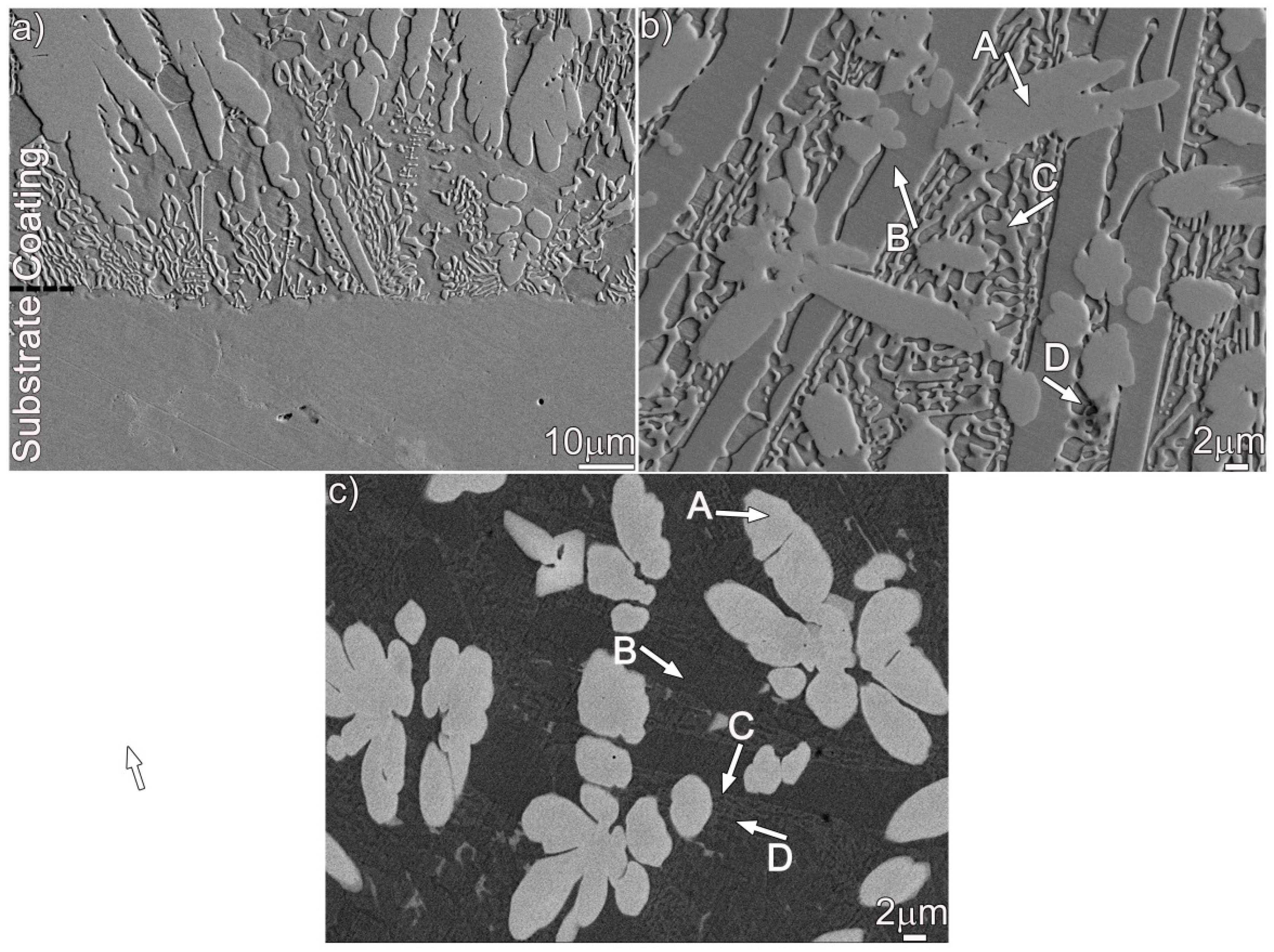
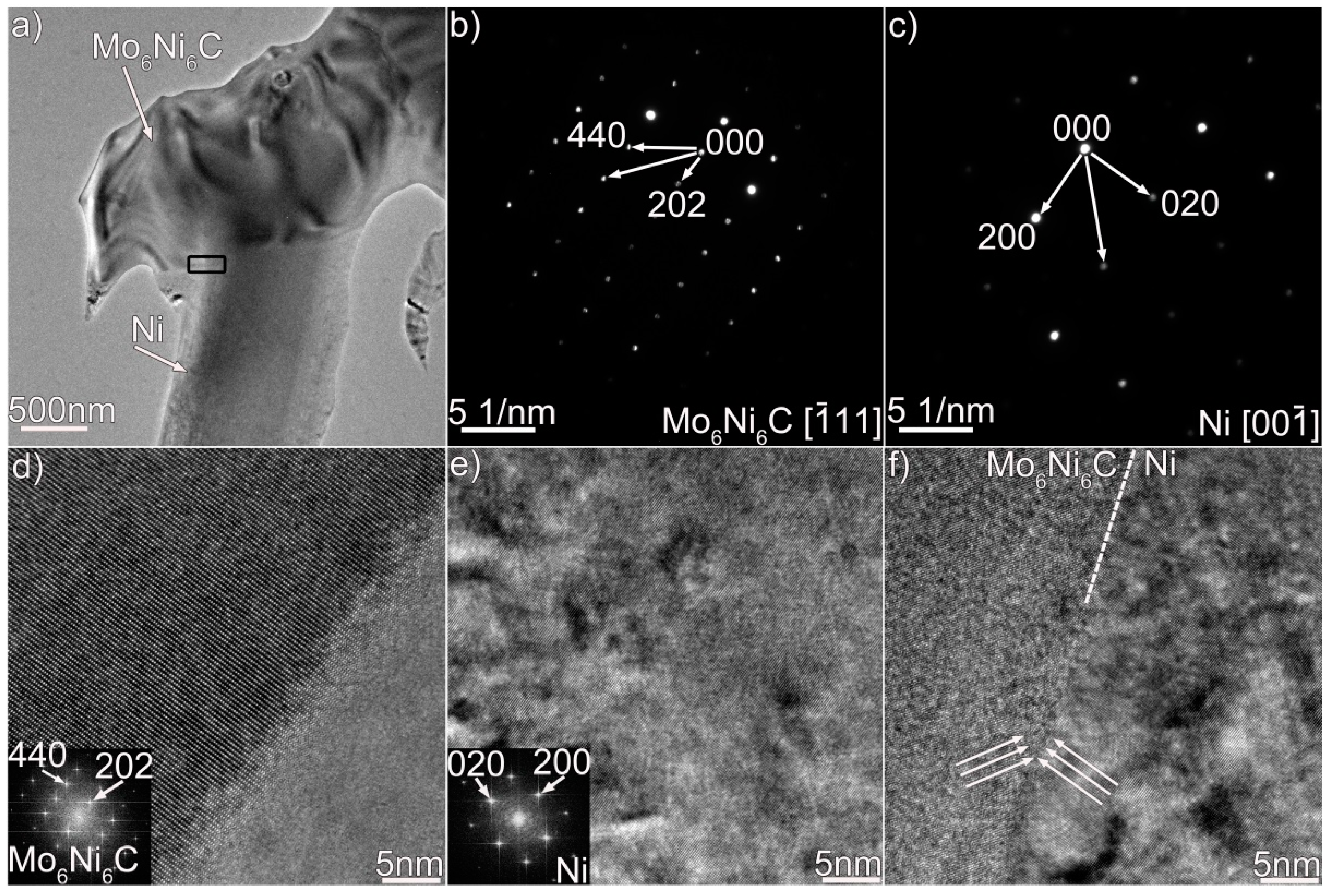
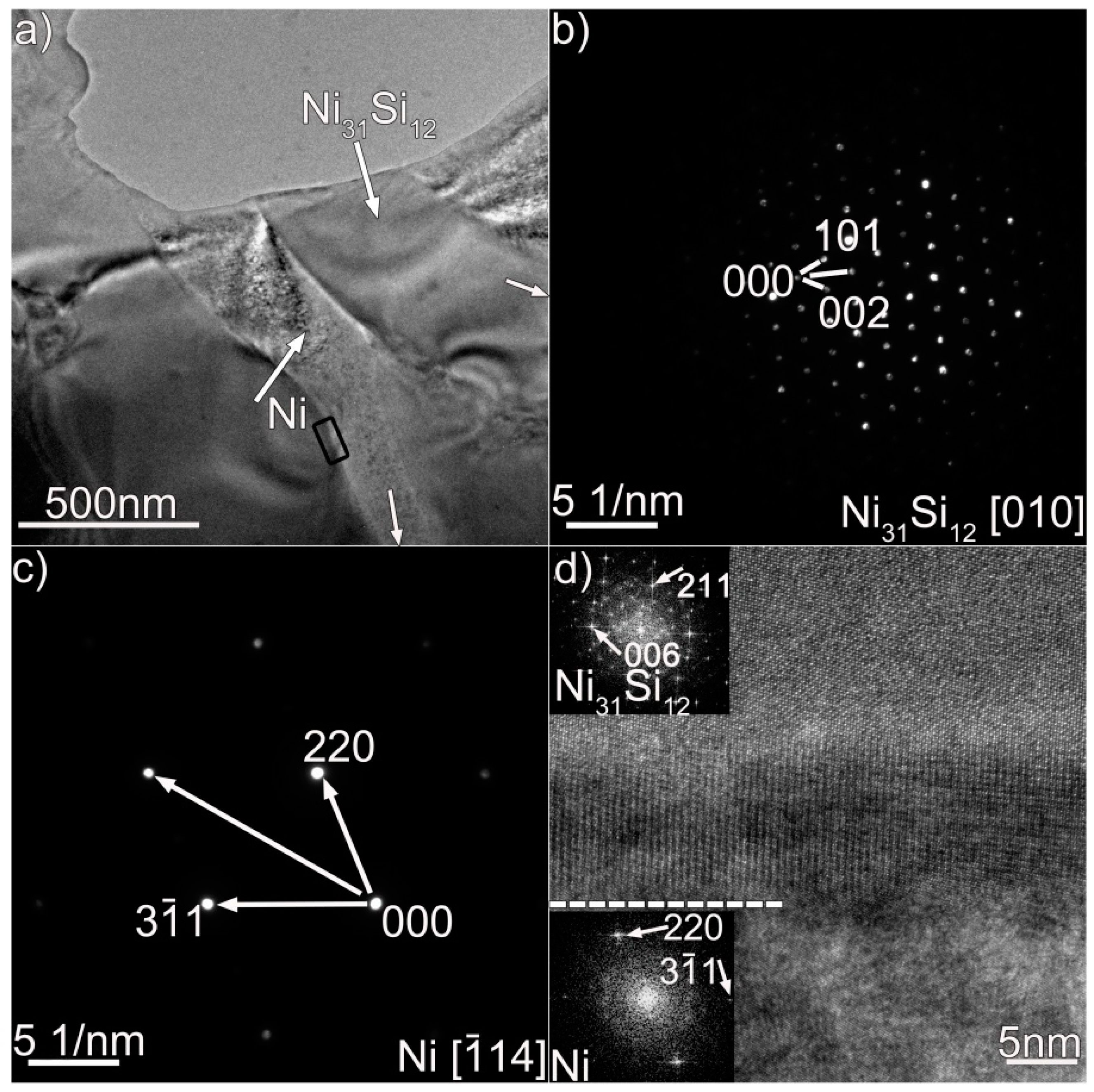
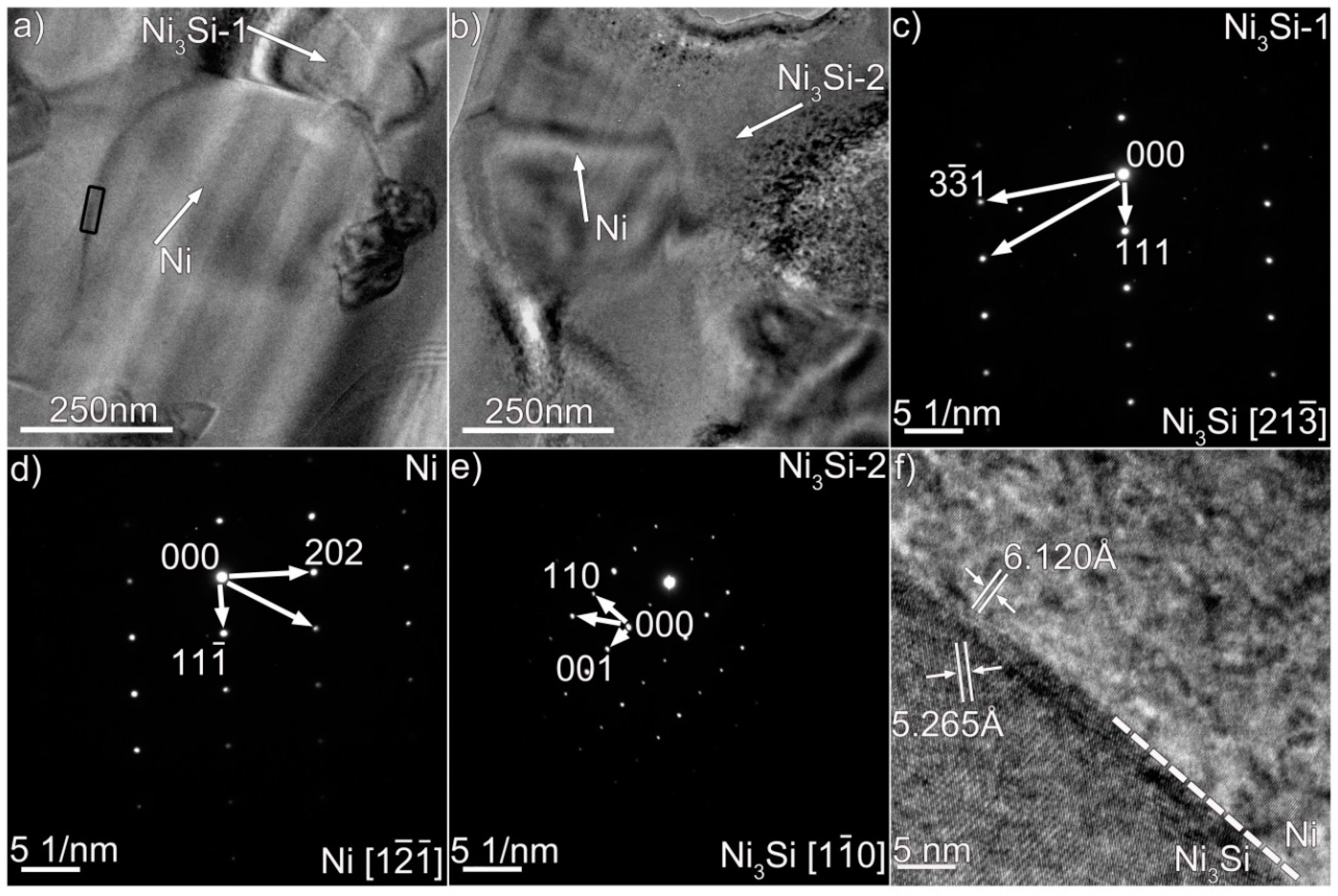
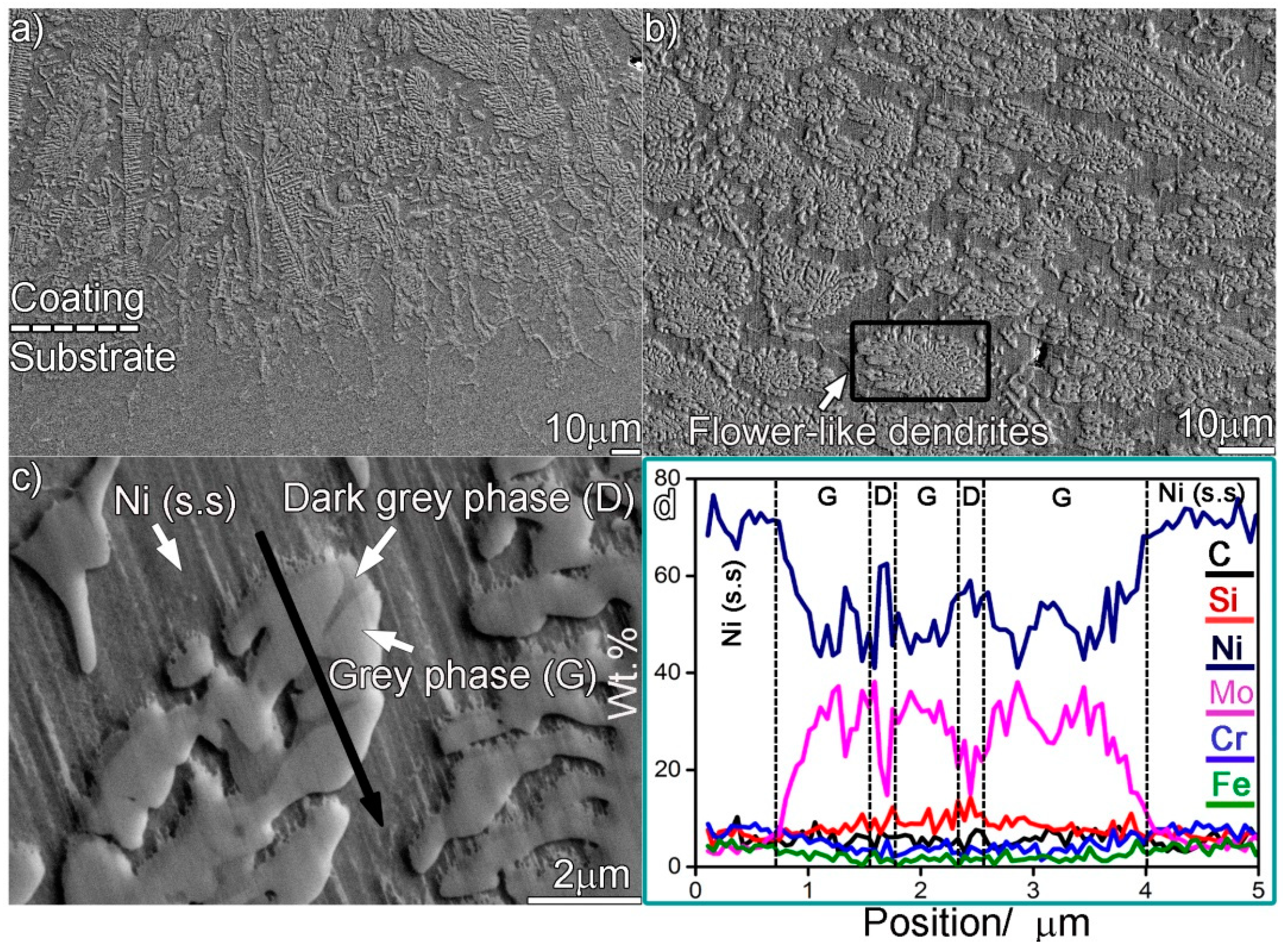
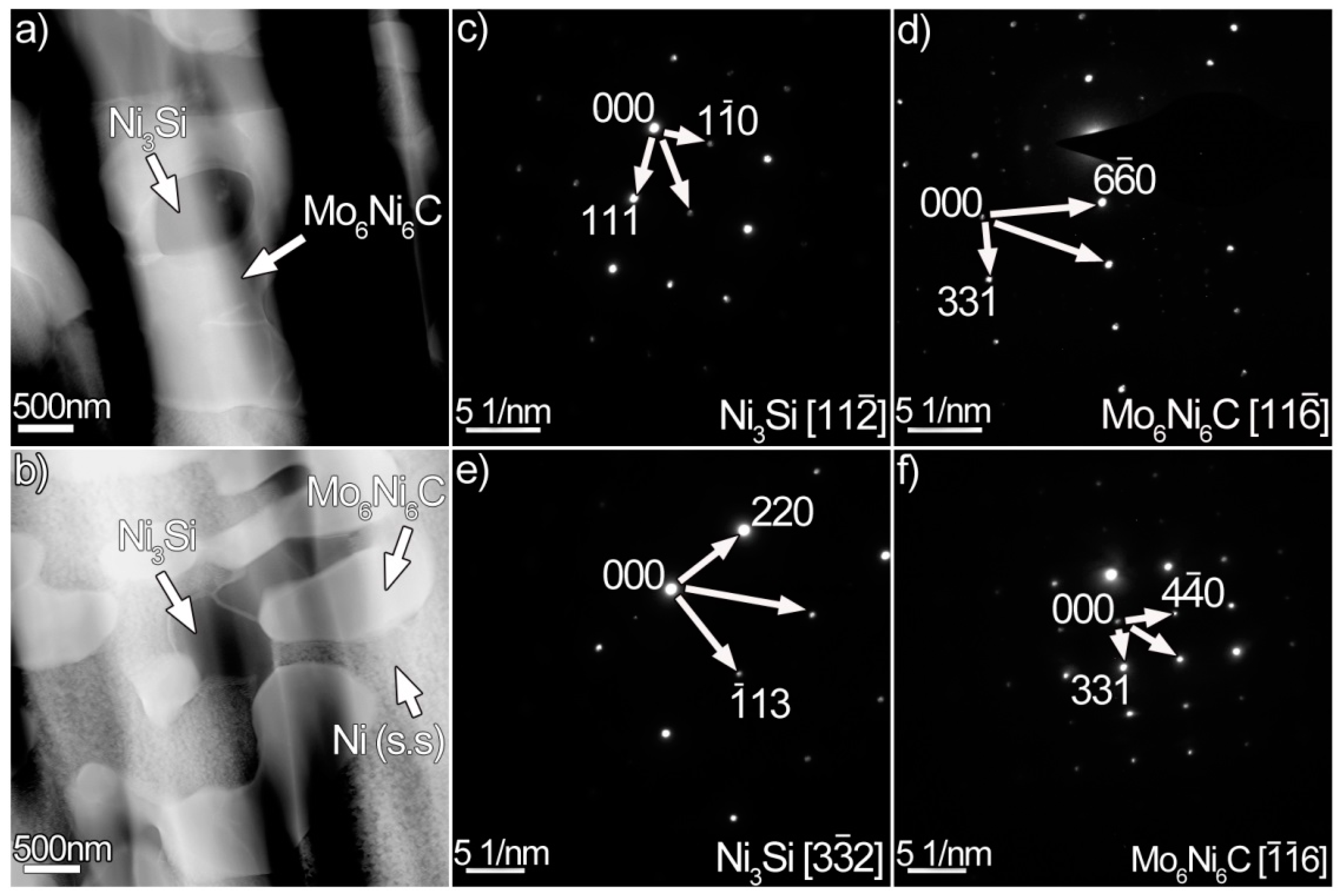

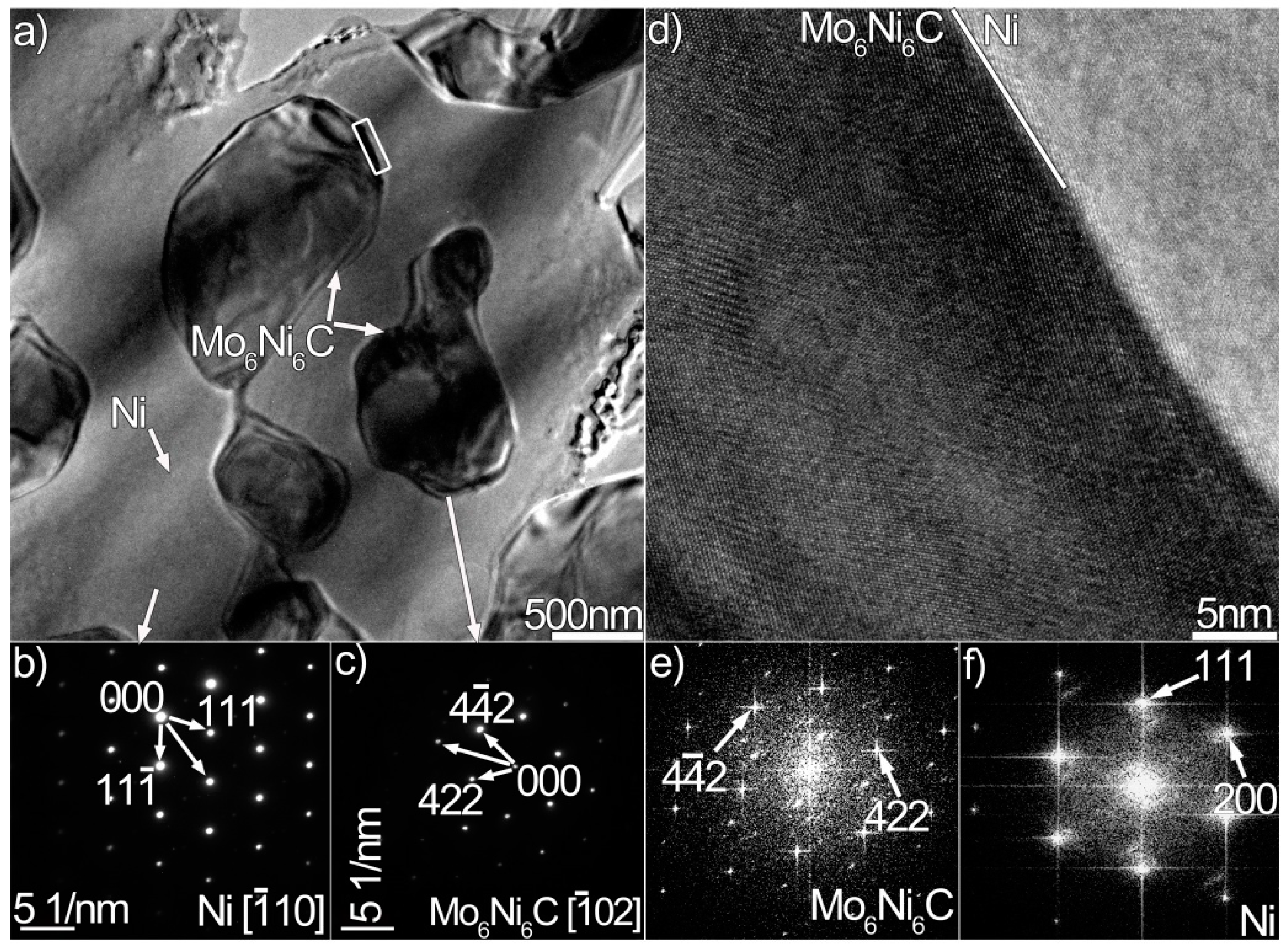


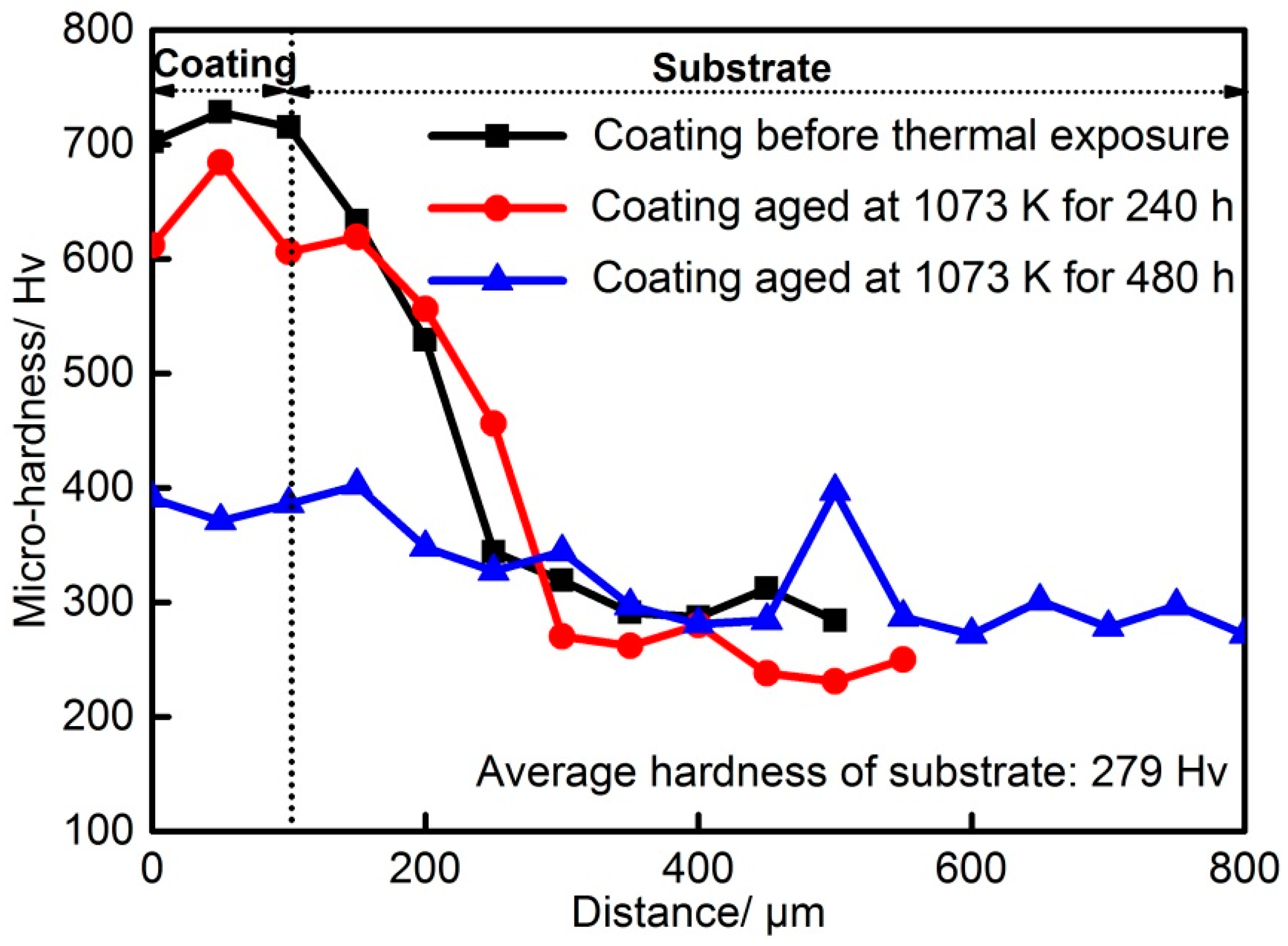
| Phase | Composition (wt.%) | |||||
|---|---|---|---|---|---|---|
| C | Si | Ni | Mo | Cr | Fe | |
| A | 5 | 11 | 43 | 33 | 6 | 2 |
| B | 4 | 15 | 76 | 1 | 2 | 2 |
| C | 4 | 16 | 74 | 1 | 3 | 2 |
| D | 4 | 7 | 65 | 2 | 13 | 9 |
© 2019 by the authors. Licensee MDPI, Basel, Switzerland. This article is an open access article distributed under the terms and conditions of the Creative Commons Attribution (CC BY) license (http://creativecommons.org/licenses/by/4.0/).
Share and Cite
Li, Y.; He, Y.; Lu, C.; Zheng, W.; Yang, J.; Wang, D.; Wang, L.; Sun, Y.; Gao, Z. Microstructural Evolution and Mechanical Evaluation of a Laser-Induced Composite Coating on a Ni-Based Superalloy during Thermal Exposure. Materials 2019, 12, 1439. https://doi.org/10.3390/ma12091439
Li Y, He Y, Lu C, Zheng W, Yang J, Wang D, Wang L, Sun Y, Gao Z. Microstructural Evolution and Mechanical Evaluation of a Laser-Induced Composite Coating on a Ni-Based Superalloy during Thermal Exposure. Materials. 2019; 12(9):1439. https://doi.org/10.3390/ma12091439
Chicago/Turabian StyleLi, Yuebing, Yanming He, Chuanyang Lu, Wenjian Zheng, Jianguo Yang, Donghong Wang, Limei Wang, Yuan Sun, and Zengliang Gao. 2019. "Microstructural Evolution and Mechanical Evaluation of a Laser-Induced Composite Coating on a Ni-Based Superalloy during Thermal Exposure" Materials 12, no. 9: 1439. https://doi.org/10.3390/ma12091439
APA StyleLi, Y., He, Y., Lu, C., Zheng, W., Yang, J., Wang, D., Wang, L., Sun, Y., & Gao, Z. (2019). Microstructural Evolution and Mechanical Evaluation of a Laser-Induced Composite Coating on a Ni-Based Superalloy during Thermal Exposure. Materials, 12(9), 1439. https://doi.org/10.3390/ma12091439





